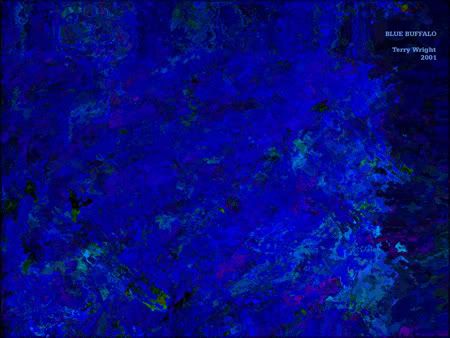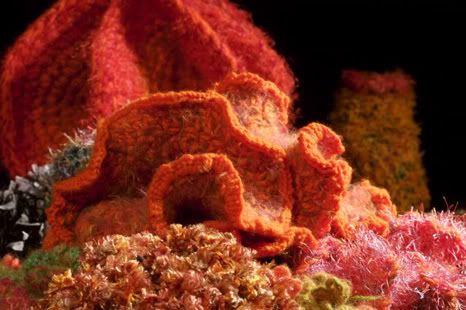
Blue Buffalo (2001)
Aristocracy has three successive ages. First superiority, then privileges, and finally vanities. Having passed from the first, it degenerates in the second, and dies in the third.
--Vicomte De Chateaubriand
It will surprise none of Orbit Trap's readers to learn we have had no reply to our inquiries about how the Fractal Universe Calendar is run. Nearly two weeks have passed since I wrote to Avalanche Press, and nearly a month has gone by since I emailed the FUC editor. We were certainly not flabbergasted to pick up only radio silence.
However, I was a little taken aback to see this year's FUC editor's busy schedule leaves her time to chat with the calendar's supporters. The propaganda machine hums along without a glitch over at the Fractalbook niche of Keith MacKay's blog. And an insular group it is. Among that blog's contributors: Keith MacKay (former FUC editor), Panny Brawley (current FUC editor), Damien M. Jones (director of the Benoit Mandelbrot Fractal Art Contest), WelshWench (retired OT heckler), and kymarto (aka Toby, another retired OT heckler). An objective bunch dedicated to carefully weighing both sides of every issue -- to be sure.
I could pose my questions to the editor there I suppose. But wait. No. I just remembered that I'm banned at that blog after making just one post months ago. I guess I have no alternative but to respond here instead.
MacKay begins his post by urging fractal artists to submit to the Fractal Universe Calendar. He recounts his hits and misses in having material accepted (without crunching his acceptance rate with all other submissions), and he explains why he had fun serving as an editor last year. He forgets to mention that part of that fun probably involved placing two of his own images in the calendar while serving as one of the competition's editors -- including gracing the front cover for the 2009 version. He dispenses this wisdom:
My advice now is to participate in the calendar for the fun of it. Don't do it for the money. I mean, it's $200, or $400 for a cover image.
Well, he should know. But we're still confused -- probably because the FUC editors and publishers refuse to answer our questions. Our adversaries (like retired OT heckler Ken) have been adamant that the FUC editors receive only the inclusion of one image as a payment -- although editors are free to include other images (how many -- no one will say) of theirs into the final cut of 200 images given to "the publishing team." Is that true (we've asked and asked)? Or was MacKay also paid a total of $600 for having his two images selected/grandfathered in? The answer appears to be: yes. Don't take my word for it. Take his. Here's what he said in an OT comment thread last July:
I am getting $600 for my 2 images. I don't know, should I turn that down for violating somebody's notion on what good fractal art is? I don't think so. I need a new lens for my camera.
I dunno, Keith. Those heavy, epistemological, what-is-art underpinnings do certainly cloud the issue. What about recasting the question? Maybe from this angle: As one of the competition's editors, do you feel that reaping such rewards yourself might be regarded in some quarters as ethically suspicious and professionally sleazy? Any reaction to that line of questioning?
So, FUC editors are paid for having their own work included. Would that not make for even more incentive (or do I mean conflict of interest) to include plenty of your own material into the pruned mix sent on to Avalanche? We might be less paranoid if the editors or publishers would just spell out the boundaries for us -- like we asked. From where we sit, it looks easy for MacKay to urge artists to participate for "the fun" when, as an editor, he took in the competition's largest monetary haul last year, and his work comprised almost 1/6 of the calendar. I guess editors do have more fun.
Later in his post, MacKay can't resist sending OT a shot. In closing, he observes:
If you do have a question or concern about the calendar, contact the editor privately. That is the right and proper way to do it.
Really? And any other way is rude? Perhaps Miss Manners should inform the FUC web site about their glaring etiquette faux pa. Here's what the FUC site recommends:
If you have any questions or queries regarding the process which have not been answered in the FAQs please contact Panny via the enquiry form.
And that's exactly what I did. I used the enquiry form to pose my questions. Heard zip back. Wasn't I, in fact, contacting the editor privately? MacKay makes it all sound so laid back and informal. Gosh, maybe I should have just driven over to Brawley's place and dropped in for Sunday brunch. We could have genteelly conversed in homespun tones as we sipped sweet tea and nibbled cornbread in the rose garden. Her butler, Wilfred Brimley, might have served us bran muffins on silver platters as he cooed: It's the right thing to do.
In contrast to our boorishness, MacKay is well bred. He certainly has no qualms about pumping up the calendar competition in a public forum when -- in keeping with his own rules of decorum -- he could have more properly sent his support to the editor privately. Apparently, defending FUC's honor in a safe Fractalbook sacristy is not ill-mannered -- or, dare one suggest, even tawdry. But we who openly question the competition's workings must be held to a different (double) standard.
And there's more juiciness to be found buried in the comments. Like this zinger from MacKay:
I am confident that Panny will show the publishers what's out there by providing them with a range of fractal styles. The editor and publisher needs to see what is available.
It's a point Brawley wholeheartedly echoes:
I wish the Publisher would include some of the newer, fresher type of images, but that's not the proven method of a viable commercial venture for them. But you can bet your bippy that they SEE some of the great new works, whether they choose them or not.
I, too, wish the publishers would choose "newer, fresher" images so the calendar-buying masses will no longer have the archetype of a fractal seared into their brains as having to be a garish, over-saturated spiral -- the image of which will likely soon be appearing next to the word fractal in dictionaries everywhere. But aren't we all glad that the publishing team at Avalanche -- experts holding advanced degrees in contemporary art, I'm sure-- get exposed to the very best we fractal artists have to offer...before chucking everything innovative and experimental into the recycle bin and once more selecting the same old same old. I mean -- really -- what's the point? Why waste everyone's time -- and, worse, build up false hopes for artists who have submitted images on the cutting edge? It's like pitching movie projects like The Departed or No Country for Old Men to China's Shaw Brothers Studios. No matter how indie and hip a project is, in the end they will always just want to make another kung fu movie about Shaolin monks. This isn't a service. It's a shadow play.
Besides, we're obviously an ungrateful lot. To hear this crowd talk, we plebes should be on our knees thanking our betters for even letting us in the door. Rick Spix makes this point:
I think some folks don't realize that the two founders of the thing probably could just as easily have not included anyone else and kept it all to themselves as Tina and Linda were/are both quite capable of coming up with 13 top-notch pix by themselves had they wanted to. And easily too, I reckon. I, for one, am pretty grateful for that act of selflessness -- truly in the spirit of the old "Stone Soap Group" from the heydays of Fractint, imho.
Big of them, right? Of course, if the founders had kept everything to themselves, it would indeed have been a private publishing venture, and OT would have absolutely no problem with any of it. Artists would have been personally contacted and then contracted to publish their work -- much like Alice Kelley does with her Fractal Cosmos calendar. Instead, the FUC became a fuzzy competition with considerable insider privileges. It's hardly an open source utopia like Fractint. No one has to compete to contribute files to that software. There are/were no ruling-overlord-editor-types in the Stone Soap Group, so there was no one receiving special privileges or insider compensation. But the FUC editors definitely get a few perks while they are having all that fun. As we've shown, 40% of the included FUC images from 2004-2008 were the work of four past or current editors.
Brawley ends her pep talk with a return back slap:
Submit -- tell your friends to submit, and have fun!
As always, I thank Keith especially for his support. It's a very welcome change from some of the press the Calendar gets every year.
Ever wonder why those negative reviews turn up on your door step each year? Tired of that annual bad press resurfacing? Here's an idea. Fix your competition in two easy steps by:
1. Make it a true publishing venture. Pay editors a stipend (as in money but not art) to solicit material directly from artists who are making fractal art that adheres to "the Avalanche look."
2. Do not include an editor's work under any circumstances.
And you're done. That's it. And you'll hear no more fuss (from us, anyway) about the process. I suspect the content angle might still draw fire from time to time, though.
And speaking of hearing nothing...
We might have less cause to accuse you of imperial behavior if you acted less like royalty who can't be bothered. It just looks bad. It looks bad when you profit from having a privileged position and then boast about buying new camera equipment with your booty. It looks bad when you land grab via self-selection 40% of your own exhibition and then bill it as being filled with "the most important fractal artists in the world." Says who? Says you. It's a solipsistic loop. Can't you see that? Here's how I think you come across:

We're the phone fractal art company. We don't care. We don't have to.
And it's true. You don't have to care. And Orbit Trap doesn't deserve a response. Ignore us -- just as our adversaries suggest. Everyone knows, after all, we're bitter and cowardly. Better to huddle in your secure Fractalbook lairs where never a discouraging word is heard. Congratulate one another about the righteousness of good deeds that come from privilege and the fortitude of actions producing mutual benefits to the conclave. Whatever else, keep that chorus singing a refrain that you deserve the status you've claimed for yourself -- especially as you enter the third stage of the aristocracy. Omnia Vanitas.
Meanwhile, out where the serfs stand in muddy water, deadlines are approaching. The competitions must go on -- and will likely draw even more participants than in previous years -- participants who hope to at least be let in for a tour of the servant's quarters. Maybe this is the year you'll twist your pixels into enough of a formulaic spiral pretzel to finally get a country club invitation -- or, at least, you'll snag an email saying you almost made the grade. Or, better yet, perhaps this go-around you'll receive one of those 50 (and why not make it 250 this year?) meaningless honorable mentions from BMFAC. Then, you can feed your dreams a steroid drip. You're empowered at last merely by rubbing elbows with the powerful. Shout your triumph to the world (in an obscure forum thread): I've reached such a level of acclaim that I will no longer even have to be juried. I can just proclaim myself a winner with a simple speech act.
Word Made Flesh. That's you. You imitated masterpieces made by the masters. You took the fractal art courses in Mississippi. You colored spirals rightly inside the properly restricted stylistic lines. You, too, deserve to carve out some exhibition space or a calendar month (or two) for yourself.
But to those of you who do submit with less success, once all the fun you're having wears off, and the results turn out to be same as it ever was, and you're left feeling empty and cheated, and you find yourself still standing in a mud hole as you watch the emperor's carriage, shades drawn, pass you by...
...don't say you weren't warned. Because if you come, hat in hand, to us here at OT and begin talking of revolution, well, we now know from being lectured by our betters what is the "right and proper way" to respond.
We'll smile condescendingly, turn the blinds up, and pretend you never said anything at all.
~/~
Image made with Fractal Zplot. Post-processed until it became so blue it quit roaming.
Tags: fractal, fractal art, fractal art contest, fractal universe calendar, avalanche publishing, panny brawley, keith mackay, benoit mandelbrot fractal art contest, the right and proper way to do it, becoming a great artist through self proclamation, blue buffalo, orbit trap






































